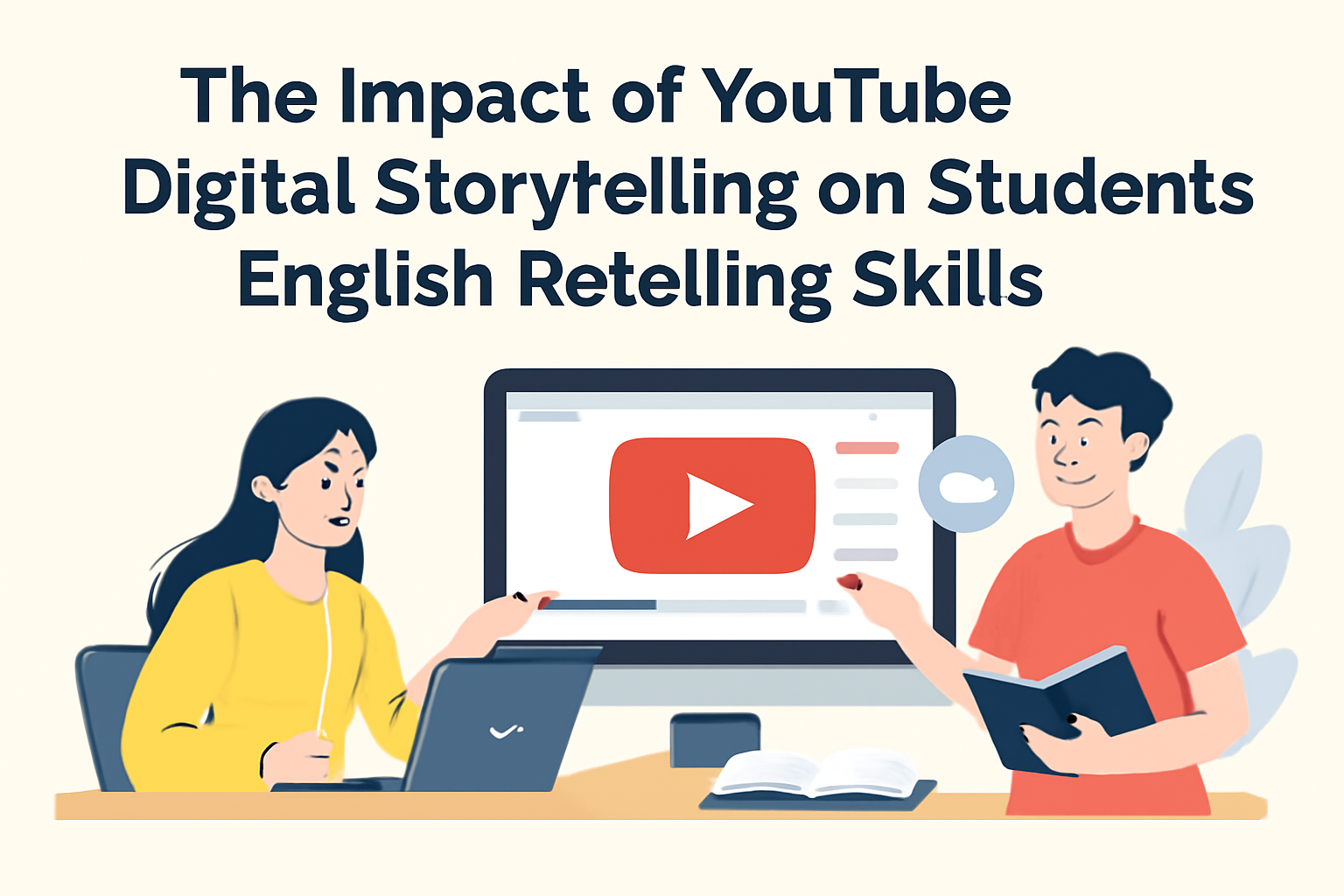The Impact of YouTube Digital Storytelling on Students’ English Retelling Skills
DOI:
https://doi.org/10.24903/bej.v7i2.2089Keywords:
youtube, digital storytelling, retelling skills, vocabulary development, speaking fluencyAbstract
This study investigates the impact of YouTube-based digital storytelling on students' English retelling skills in an EFL context. The research was motivated by students' common struggles with vocabulary retention, speaking fluency, and confidence when retelling stories in English. Utilizing a mixed-method approach, the study involved 55 students from the English Education Program at Universitas Muhammadiyah Kalimantan Timur. Data were collected through a Likert-scale questionnaire and semi-structured interviews. Quantitative data were analyzed using SPSS to obtain mean scores and descriptive statistics, while qualitative data were examined using thematic analysis. The findings revealed that digital storytelling significantly improved students' vocabulary, fluency, and confidence. Interview responses supported these results, highlighting how visual and audio elements in YouTube storytelling helped students recall new words, understand narrative structure, and express ideas with greater ease. The study concludes that YouTube digital storytelling is an effective, engaging, and accessible tool for enhancing retelling skills in EFL learners. The originality of this study lies in its focus on integrating multimodal digital input with narrative learning, offering pedagogical insights into low-resource and tech-friendly learning strategies for speaking development.
References
Alkamel, M. (2024). Social Media in Teaching English for EFL Students: A Review of Challenges and Suggestions. International Journal of English Teaching and Learning, 2(1), 8–17. https://doi.org/10.11648/j.ijetl.20240201.12
Aminah, S., Nur, D. R., & Ariyanti, A. (2019). An Analysis of Teacher Talk used by English Teacher at SMKN 5 Samarinda. Borneo Educational Journal (Borju), 1(1), 22–28. https://doi.org/10.24903/bej.v1i1.256
Anggeraini, Y. (2020). ELT-Lectura: Studies and Perspectives in English Language Teaching Volume An Investigation of the Students Opinion on the Use of Digital Storytelling in Learning English. 7(1).
Arbain, A., & Nur, D. R. (2017). Techniques for teaching speaking skill in Widya Gama Mahakam University. Script Journal: Journal of Linguistics and English Teaching, 2(1), 13–25. https://doi.org/10.24903/sj.v2i1.80
Arbain, A., & Rohman, A. (2023). Dubbing as a Pedagogical Tool: An Experimental Study on Eleventh-Grade Students at SMAN 8 Samarinda. EDUCASIA: Jurnal Pendidikan, Pengajaran, Dan Pembelajaran, 8(2), 147–156. https://doi.org/10.21462/educasia.v8i2.155
Arbain, A., Taufik, A., & Nur, D. R. (2017). Daily English Phrases Book. UWGM Press.
Bernad-Mechó, E., & Valeiras-Jurado, J. (2023). Engaging The Audience In Online Youtube Science Dissemination Videos: A Look At The Uptake Of Multimodal Engagement Strategies. Esp Today, 11(2), 302–327. Https://Doi.Org/10.18485/ESPTODAY.2023.11.2.6
Braun, V., & Clarke, V. (2019). Reflecting on reflexive thematic analysis. Qualitative Research in Sport, Exercise and Health, 11(4), 589–597. https://doi.org/10.1080/2159676X.2019.1628806
Durotul Yatima. (2024). Peningkatan Keterampilan Menceritakan Kembali Fabel Melalui Paired-Storytelling Berbantuan Video Youtube Kelas Ii . Jguruku: Jurnal Penelitian Guru, 2(1), 601–607.
Erliana, U., & Arbain, A. (2020). The Effectiveness of Using Video Clip in Teaching English Vocabulary at SD Fastabiqul Khairat Samarinda. IJOTL-TL: Indonesian Journal of Language Teaching and Linguistics, 5(2), 123–134. https://doi.org/10.30957/ijoltl.v5i2.623
Fitri, H. A., & Harianingsih, I. (2021). Edulangue Implementing Digital Storytelling-Based Tasks For The Teaching Of Narrative Writing Skills. In Journal of English Language Education (Vol. 4, Issue 2).
Gracella, J., & Rahman Nur, D. (2020). Students’ Perception of English Learning through YouTube Application. Borneo Educational Journal (Borju), 2(1), 20–35. https://doi.org/10.24903/bej.v2i1.623
Friska, Y. (2022). Problems in Reading Comprehension of TOEFL Prediction Test. Journal of English Language and Education, 7(2), 96–104. https://doi.org/10.31004/jele.v7i2.310
Fu, J. S., Yang, S. H., & Yeh, H. C. (2022). Exploring the impacts of digital storytelling on English as a foreign language learners’ speaking competence. Journal of Research on Technology in Education, 54(5), 679–694. https://doi.org/10.1080/15391523.2021.1911008
Maya, L., & Labib Al Halim, M. (2021). The Effectiveness Of Digital Storytelling For Young Learners’ Vocabulary Mastery (Issue 02).
Muhammad Iqbal Tawaqal, & Akbar Dwi Rizqyan. (2024). Enhancing English Language Proficiency In Grade 1 Junior High School: The Impact Of Youtube Videos As A Learning Tool. Global Synthesis in Education Journal, 1(2), 33–40. https://doi.org/10.61667/gzyd5d86
Nur, D. R. (2020). Virtual Reality adoption in Indonesia higher Education from lecturer’s voice. English Teaching Journal: A Journal of English Literature, Language and Education, 8(1), 31–35. https://doi.org/10.25273/etj.v8i1.6672
Nur, D. R., & Jamilah, J. (2022). English Language Imperative Level in Indonesia. Intensive Journal, 5(1), 36–43. http://dx.doi.org/10.31602/intensive.v5i1.5986
Rattri, A. R. W., & Rachman, D. (2024). Using Digital Game Wordwall in Supporting English Vocabulary Mastery. Borneo Educational Journal (Borju), 6(2), 115–127. https://doi.org/10.24903/bej.v6i2.1657
Rosalina, E., & Nasrullah, N. (2025). Technology Integration In English Language Teaching And Learning Penerbit Cv.Eureka Media Aksara. https://www.researchgate.net/publication/390299517
Saed, H. A., Haider, A. S., Al-Salman, S., & Hussein, R. F. (2021). The use of YouTube in developing the speaking skills of Jordanian EFL university students. Heliyon, 7(7). https://doi.org/10.1016/j.heliyon.2021.e07543
Sinaga, N. T. (2019). The Performance of English Department Students in Retelling Story: An Anthropolinguistic Study. International Journal of Research & Review (Www.Ijrrjournal.Com) Vol, 6(8). www.ijrrjournal.com

Downloads
Published
How to Cite
Issue
Section
License
Copyright (c) 2025 Rabi'ah Al-Adawiyah, Dzul Rachman, Ade Ismail Ramadhan Hamid

This work is licensed under a Creative Commons Attribution 4.0 International License.
Authors retain copyright and grant the journal right of first publication with the work simultaneously licensed under a Creative Commons Attribution 4.0 International License that allows others to share the work with an acknowledgment of the work's authorship and initial publication in this journal.



